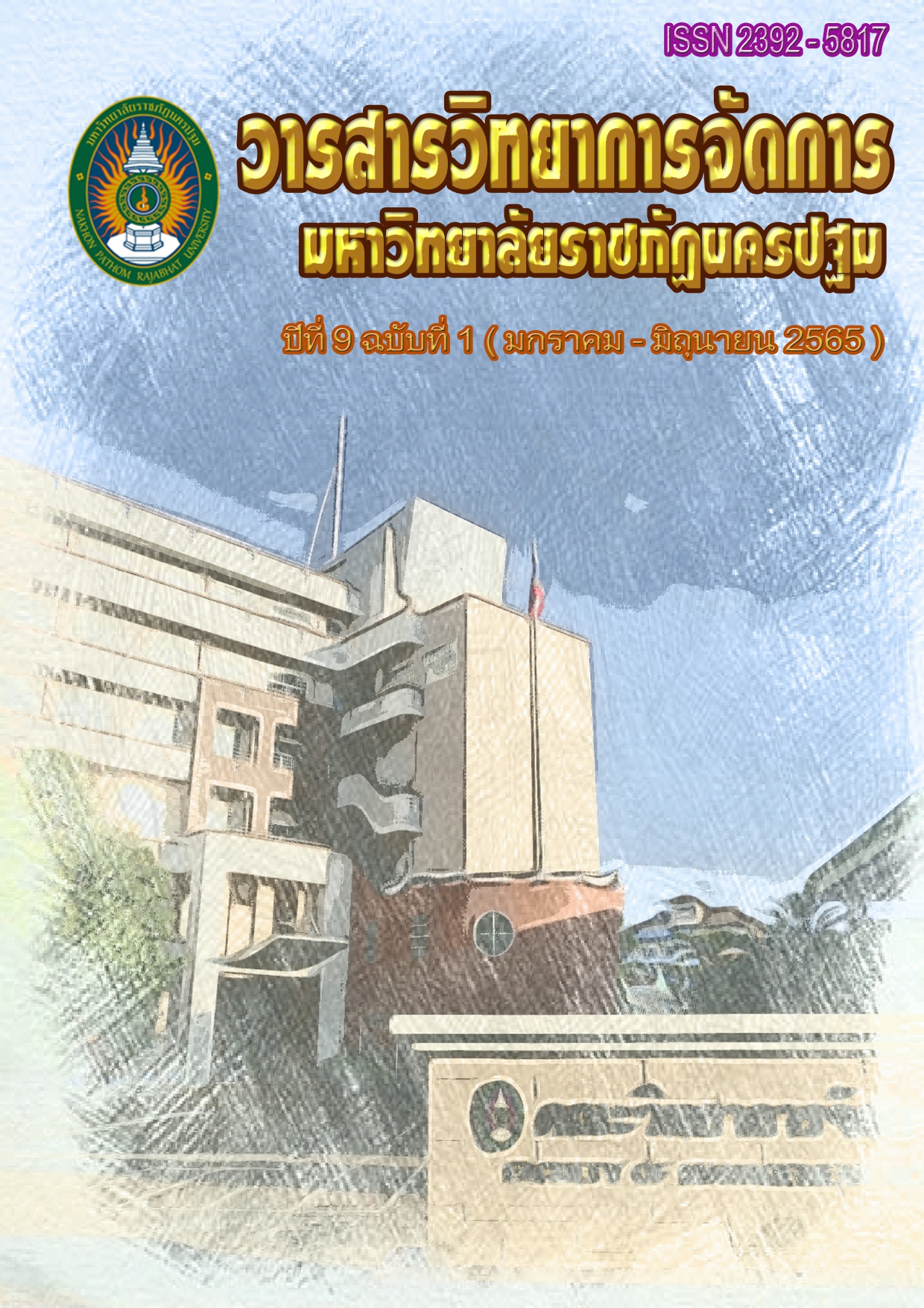บุพปัจจัยต่อการรับรู้การสนับสนุนขององค์การและพฤติกรรมการเป็นสมาชิกที่ดีขององค์การ ที่มีผลต่อการคงอยู่ของผู้แทนยากลุ่มอุตสาหกรรมยาในประเทศไทย
Main Article Content
บทคัดย่อ
บทความวิจัยนี้มีวัตถุประสงค์เพื่อ (1) ศึกษาอิทธิพลเชิงสาเหตุของตัวแบบสมการโครงสร้างบุพปัจจัยต่อการรับรู้การสนับสนุนขององค์การและการเป็นสมาชิกที่ดีขององค์การที่มีผลต่อการคงอยู่ของผู้แทนยากลุ่มอุตสาหกรรมยาในประเทศไทย และ (2) ศึกษาความคิดเห็นของผู้แทนยาที่มีความเชี่ยวชาญในประเด็นเกี่ยวกับบุพปัจจัยต่อการรับรู้การสนับสนุนขององค์การและการเป็นสมาชิกที่ดีขององค์การที่มีผลต่อการคงอยู่ของผู้แทนยากลุ่มอุตสาหกรรมยาในประเทศไทย ใช้การวิจัยแบบผสมผสานวิธี โดยงานวิจัยเชิงปริมาณ เก็บข้อมูลด้วยแบบสอบถามจากผู้แทนยา 533 คน สุ่มตัวอย่างแบบหลายขั้นตอน ประมวลผลด้วยการวิเคราะห์ตัวแบบสมการโครงสร้าง งานวิจัยเชิงคุณภาพ เก็บผู้ให้ข้อมูลหลัก จำนวน 5 คน เลือกตัวอย่างแบบเจาะจง วิเคราะห์ข้อมูลโดยวิธีอุปนัย เพื่อสนับสนุนผลการวิจัยเชิงปริมาณ
ผลการวิจัยพบว่า (1) แบบจำลองเชิงสาเหตุของงานวิจัยกับข้อมูลเชิงประจักษ์ สอดคล้องกลมกลืนดี โดยมีค่า /df =1.30 P=0.07 และ RMSEA=0.02 อธิบายความแปรปรวนของการคงอยู่ของผู้แทนยาได้ร้อยละ 88 และการรับรู้การสนับสนุนขององค์การมีค่าอิทธิพลโดยรวมต่อการคงอยู่ของพนักงานสูงสุด เท่ากับ 0.75 และการมีส่วนร่วมในงานส่งผลทางลบต่อการคงอยู่ของพนักงาน เท่ากับ -0.20 อย่างมีนัยสำคัญทางสถิติที่ระดับ 0.05 และ (2) ผลการวิจัยเชิงคุณภาพสนับสนุนผลการวิจัยเชิงปริมาณทุกประเด็น โดยเฉพาะตัวแปรการมีส่วนร่วมในงานที่มีผลทางลบต่อการคงอยู่ของพนักงาน จากการสัมภาษณ์พบว่า เมื่อผู้แทนยามีส่วนร่วมในการวางแผนยอด การรับรู้ค่าตอบแทนตามเป้าหมาย ทำให้ผู้แทนยาเกิดการเปรียบเทียบกับบริษัทคู่แข่ง เป็นสาเหตุทำให้มีการโยกย้ายไปทำงานบริษัทอื่น
*1,2 คณะบริหารธุรกิจ มหาวิทยาลัยรามคำแหงแขวงหัวหมาก เขตบางกะปิ กรุงเทพมหานคร 10240
Corresponding author: heart.tipsukhon@gmail.com
Article Details

อนุญาตภายใต้เงื่อนไข Creative Commons Attribution-NonCommercial-NoDerivatives 4.0 International License.
ทัศนะและข้อคิดเห็นของบทความที่ปรากฏในวารสารฉบับนี้เป็นของผู้เขียนแต่ละท่าน ไม่ถือว่าเป็นทัศนะและความรับผิดชอบของกองบรรณาธิการ
เอกสารอ้างอิง
นพรัตน์ ตั้งเวนิชเจริญสุข. (2560). ปัจจัยที่มีผลต่อการลาออกของผู้แทนยา. วิทยานิพนธ์เศรษฐศาสตร์มหาบัณฑิต, มหาวิทยาลัยธรรมศาสตร์.
มาเก็ตตี้ ออนไลน์. (2563). ตลาดยาไทยโตรองแค่อินโด AI เทรนด์ใหญ่กำหนดทิศทาง. [ออนไลน์]. สืบค้นเมื่อ 27 มิถุนายน 2563, จาก https://marketeeronline.co/ archives/102120"
สราวุธ สันติวุฒิกุล และ ตุลยา ตุลาดิลก. (2563). การวิเคราะห์การดำเนินงานด้านงานขายของหัวหน้าทีมขายและผู้แทนยา บริษัท มิลลิเมด จำกัด. วารสารบริหารธุรกิจมหาวิทยาลัยเชียงใหม่, 6(3), 82-90.
สุชาติ ประสิทธิ์รัฐสินธุ์. (2555). ระเบียบวิธีการวิจัยทางสังคมศาสตร์ (พิมพ์ครั้งที่ 15). กรุงเทพฯ: สามลดา.
เอ็มเคทีฟาร์ม่า. (2563). ทักษะและความรู้ที่จำเป็นสำหรับนักการตลาดยาในปี 2559. [ออนไลน์]. สืบค้นเมื่อ 27 มิถุนายน 2563, จาก https://mktpharma.wordpress.com/
Albaliwi, A. S., Naugton, S., Elayan, M. B., & Sleimi, M. T. (2019). Perceived organizational support, alternative job opportunity, organizational commitment, job satisfaction and turnover intention: A moderated-mediated model. Organizacija, 52(4), 310-324.
Alias, N. E., Zailan, N. A., Jahya, A., Othman, R., & Sahiq, A. N. M. (2019). The effect of supportive work environment on employee retention at Malaysia Information, Communication, and Technology (ICT) Industry. International Journal of Academic
Research in Business and Social Sciences, 9(8), 61-77. Alkahtani, A. (2015). Organizational citizenship behavior and rewards. International Business Research, 8(4), 210-222.
Allen, N. J., & Meyer, J. P. (1990). The measurement and antecedents of affective, continuance and normative commitment to the organization. Journal of Occupational Psychology, 63(1), 1-18.
Al-Maabadi, A. A. (2020). Job Involvement, and career retention rate among nursing personnel in Saudi Arabia. SSRG International Journal of Nursing and Health Science 6(1), 58-65.
Best, J. W., & Kahn, J. V. (1995). Research in education (7th ed.). New Delhi, India: Prentice Hall of India.
Brough, P., Timms, C., Chan, X. W., Hawkes, A., & Rasmussen, L. (2020). Work–life balance: Definitions, causes, and consequences. [Electronic version]. Griffith University, Queensland, Australia. from https://research-repository.griffith.edu.au/bitstream/ handle/ 10072/399143/Brough431772Accepted.pdf?sequence=2
Das, B. L., & Baruah, M. (2013). Employee retention: A review of literature. IOSR Journal of Business and Management (IOSR-JBM), 14(2), 8-16.
Hair, J. F., Black, W. C., Babin, B. J., & Anderson, R. E. (2014). Multivariate data analysis (7th ed.). Essex, UK: Pearson Education.
Hinkle, D. E., William, W., & Stephen, G. J. (1998). Applied statistics for the behavior Sciences (4th ed.). New York: Houghton Mifflin.
Iddagoda, Y. A., Opatha, H., & Gunawardana, K. D. (2016). Towards a conceptualization and an operationalization of the construct of employee engagement. International Business Research, 9(2), 85-90.
Jabri, B. A., & Ghazzawi, I. (2019). Organizational commitment: A review of the conceptual and empirical literature and a research agenda. International Leadership Journal, 11(1), 78-119.
Kamalaveni, M. A., Ramesh, S., & Vetrive, T. (2019). A review of literature on employee retention. International Journal of Innovative Research in Management Studies (IJIRMS), 4(4), 1-10.
Karim, D. N., Baset, M. A., & Rahman, M. M. (2019). The effect of perceived organizational support on intention to stay: The mediating role of job involvement. The Jahangirnagar Journal of Business Studies, 8(1), 21-30.
Katz, D. (1964). The motivational basis of organizational behavior. Behavioral Science, 9, 13-46.
Kotler, P., & Armstrong, G. (2001). Principles of marketing (9th ed.). NJ: Prentice-Hall.
Management Study Guide. (2020). Performance appraisal. Retrieved June 27, 2020, from https://www.managementstudyguide.com/performance-appraisal.htm
Mirzaee, M., & Beygzadeh, Y. (2017). Study of the impact of organizational citizenship behavior on job involvement staff self-discipline (A case study case: West Azerbaijan Tax Affairs Office, Iran). European Journal of Management and Marketing Studies. 2(1), 111-120.
Mohamed, S. A., & Ali, M. (2015). The influence of perceived organizational support on employees’ job performance. International Journal of Scientific and Research Publications, 5(4), 1-6.
Robbins, S. P. & Judge, T. A. (2013). Organizational behaviour (15th ed.). Prentice Hall, United States of America.
Rovinelli, R. J., & Hambleton, R. K. (1977). On the use of content specialists in the assessment of criterion referenced test item validity. Dutch Journal of Educational Research, 2(2), 49-60.
Saed, R. A., & Hussein, A. H. (2019). Impact of organizational citizenship behavior on organizational commitment on Jordanian frontline employees of Arabic Bank. European Scientific Journal, 15(10), 184.
Singh, A., & Gupta, B. (2015). Job involvement, organizational commitment, professional commitment, and team commitment. Benchmarking: An International Journal, 22(6), 1192-1211.
Sittisom, W. (2020). Factors affecting job satisfaction of employees in pharmaceutical industry: A case study of Thailand. A Multifaceted Review Journal in the Field of Pharmacy, 11(3), 125-133.
Soenanta, A., Akbar, M., & Sariwulan, T. (2020). The effect of job satisfaction and organizational commitment to employee retention in a lighting company. Business Management and Economics, 8(4), 97-103.
Soetjipto, N., Priyohadi, N. D., Sulastri, S., & Riswanto, A. (2021). The effect of company climate, organization citizenship behavior, and transformational leadership on work morale through employee job satisfaction. Management Science Letters, 11, 1197-1204.
Sulistyawati, U. S., & Sufriadi, D. (2020). Perceived organization support towards employee engagement and the impact of employee job satisfaction. International Journal of Social Science and Business, 4(4), 513-518.
Yoshimura, A. (1996). A review and proposal of job involvement (Festschrift for Prof. Yoko Sano). Keio business review, 33, 175-184.


